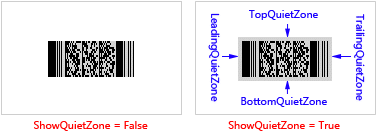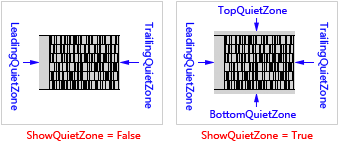Width: Single; Returns the horizontal width of the rotated barcode symbol in dots or pixels in the horizontal direction (using the horizontal resolution).
If the quiet zones are displayed (please read the ShowQuietZone parameter section below about whether or not the quiet zones will be displayed), they are included in the barcode symbol. See diagram (the quiet zones are drawn in claSilver color in order to accentuate them):

For the TBarcodeFmx2D_Code16K barcode component, the leading quiet zone and the trailing quiet zone are included always, even if the ShowQuietZone parameter is set to false. See diagram (the quiet zones are drawn in claSilver color in order to accentuate them):

Height: Single; Returns the vertical height of the rotated barcode symbol in dots or pixels in the vertical direction (using the vertical resolution).
If the quiet zones are displayed (please read the ShowQuietZone parameter section below about whether or not the quiet zones will be displayed), they are included in the barcode symbol. See diagram (the quiet zones are drawn in claSilver color in order to accentuate them):

For the TBarcodeFmx2D_Code16K barcode component, the leading quiet zone and the trailing quiet zone are included always, even if the ShowQuietZone parameter is set to false. See diagram (the quiet zones are drawn in claSilver color in order to accentuate them):

SymbolWidth: Single; Returns the distance between the leading and trailing of the rotated barcode symbol in dots or pixels (using the horizontal resolution).
If the quiet zones are displayed (please read the ShowQuietZone parameter section below about whether or not the quiet zones will be displayed), they are included in the barcode symbol. See diagram (the quiet zones are drawn in claSilver color in order to accentuate them):

For the TBarcodeFmx2D_Code16K barcode component, the leading quiet zone and the trailing quiet zone are included always, even if the ShowQuietZone parameter is set to false. See diagram (the quiet zones are drawn in claSilver color in order to accentuate them):

See also the "BarcodeWidth" property.
SymbolHeight: Single; Returns the distance between the top and bottom of the rotated barcode symbol in dots or pixels (using the vertical resolution).
If the quiet zones are displayed (please read the ShowQuietZone parameter section below about whether or not the quiet zones will be displayed), they are included in the barcode symbol. See diagram (the quiet zones are drawn in claSilver color in order to accentuate them):

See also the "BarcodeHeight" property.
Barcode: String; Specifies the barcode text. It is of type string, and it is in it fact an UnicodeString. By default, the unicode string will be converted to an UTF-8 bytes sequence (the BOM isn't included), then be encoded into the barcode symbol. If you want to use other encoding scheme (for example the ANSI, UTF-16), please convert it in the OnEncode event handle, or use the DrawToSize (Syntax 3) overloading method and specify the converted bytes sequence in its Data parameter. If you want to encode a block of binary (bytes) data, please use the DrawToSize (Syntax 3) overloading method.
For the TBarcodeFmx2D_RSS14 and TBarcodeFmx2D_RSSLimited components, if the property AutoCheckDigit is set to true, the check digit doesn't need to be included in the parameter, otherwise the check digit can be specified by you in the parameter.
ShowQuietZone: Boolean; Specifies whether to include the leading quiet zone, trailing quiet zone, top quiet zone, and bottom quiet zone in the barcode symbol. If the parameter value is set to true, these quiet zones are included. Otherwise, they don't be included. You can use the LeadingQuietZone, TrailingQuietZone, TopQuietZone, and BottomQuietZone properties to specify the size of these quiet zones in modules. See diagram (the quiet zones are drawn in claSilver color in order to accentuate them):

For the TBarcodeFmx2D_Code16K barcode component, leading quiet zone and trailing quiet zone will be included always, even if the ShowQuietZone parameter value is set to false. See diagram (the quiet zones are drawn in claSilver color in order to accentuate them):

See also the "ShowQuietZone" property.
Module: Single; Specifies the module size in dots or pixels (using the horizontal resolution).
For the Matrix 2D barcode symbology (excluding the TBarcodeFmx2D_MaxiCode barcode symbology), the module is single cell (a suqare shape) used to encode one bit data. The parameter specifies the module width and height. See diagram:

For the TBarcodeFmx2D_MaxiCode barcode symbology, the module is single cell (a regular hexagonal shape) used to encode one bit data. The parameter specifies the horizonal width of a module. Also, it's the center to center horizontal distance between adjacent modules. See diagram:

For the Stacked 2D barcode symbology and Linear 1D barcode symbology, the module is the thinest bar (or space) in the barcode symbol. The parameter specifies the module width. See diagram:

See also the "Module" property.
Angle: Single; Specifies an angle in degrees to rotate the barcode symbol and its quiet zones (if they are drawn, please read the ShowQuietZone parameter section above about whether or not the quiet zones will be drawn) anticlockwise. It defaults to 0 if the parameter is not provided, meaning left to right horizontal direction. See diagram (the quiet zones are drawn in claSilver color in order to accentuate them):

Canvas: TCanvas; Specifies target canvas to drawn the barcode symbol on it. The parameter is useful for obtaining the physical resolution if one of HDPI and VDPI parameters is set to 0. If both HDPI and VDPI parameters are set to 0, or both HDPI and VDPI parameters are not set to 0, the parameter will be ignored, in this case, you can set it to nil.
HDPI: Integer, Specifies the horizontal resolution of canvas in DPI. It's the number of dots or pixels per inch. It defaults to 0 if the HDPI is not provided, and the physical horizontal resolution obtained from the Canvas parameter will be used. If both HDPI and VDPI are set to 0, it indicates the horizontal resolution is equal to the vertical resolution.
VDPI: Integer, Specifies the vertical resolution of canvas in DPI. It's the number of dots or pixels per inch. It defaults to 0 if the VDPI is not provided, and the physical vertical resolution obtained from the Canvas parameter will be used. If both VDPI and HDPI are set to 0, it indicates the vertical resolution is equal to the horizontal resolution.